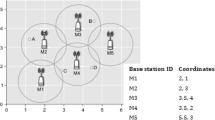Abstract
Internet of things (IoT) is a modern technology where data can be transmitted to any things (human, animal, or object) over communications networks, whether internet or intranet. Congestion occurs when the input data rate to the node was higher than the output data rate of node. Congestion control in computer network modulates traffic entry into a network in order to avoid congestive. This paper suggests a method for congestion control in the internet of things in two phases. The first phase is intra-cluster congestion control, which uses two parameters, congestion score (CS) and buffer empty space (BES), to congestion avoidance. In this phase based on these two parameters, nine states are defined to determine the congestion status of each node, and based on these 9 states the appropriate decision is made to the node. The second phase is inter-cluster congestion control. In this phase, after determining cluster head priority, the parameters of back-off timer (BFT), waiting time to receive acknowledgment \(({\text {WTTR}}_{\text {ACK}})\), sequence number (SEQ) and retransmission counter (RC) are used for congestion control. The proposed congestion control method is simulated by NS-2 software. A comparison between the performance of proposed method and conventional methods shows that applying proposed method results in a significant improvement in average congestion score (CS), packet lost rate, energy consumption and end-to-end delay.









Similar content being viewed by others
References
Anani W, Ouda A, Hamou A (2019) A survey of wireless communications for IoT echo-systems. In: 2019 IEEE Canadian Conference of Electrical and Computer Engineering (CCECE). IEEE, pp 1–6
Din IU, Guizani M, Kim BS, Hassan S, Khan MK (2018) Trust management techniques for the internet of things: a survey. IEEE Access 7:29763–29787
Sabry SS, Qarabash NA, Obaid HS (2019) The road to the internet of things: a Survey. In: 2019 9th Annual Information Technology, Electromechanical Engineering and Microelectronics Conference (IEMECON). IEEE, pp 290–296
Zhang L, Liang YC, Xiao M (2018) Spectrum sharing for internet of things: a survey. IEEE Wirel Commun 26(3):132–139
Li S, Peng S, Liao X, Zhu P, Peng Y (2007) A framework for congestion control for reliable data delivery in wireless sensor networks. In: 2007 10th IFIP/IEEE international symposium on integrated network management. IEEE, pp 793–796
Mishra N, Verma LP, Srivastava PK, Gupta A (2018) An analysis of IoT congestion control policies. Proc Comput Sci 132:444–450
Poddar M, Chaki R, Pal D (2018) Congestion control for IoT using channel trust based approach. In: IFIP International Conference on Computer Information Systems and Industrial Management. Springer, Cham, pp 392–404
Naghibi M, Barati H (2020) EGRPM: Energy efficient geographic routing protocol based on mobile sink in wireless sensor networks. Sustain Comput Inform Syst 25:100377
Qazi IA, Znati T (2011) On the design of load factor based congestion control protocols for next-generation networks. Comput Netw 55(1):45–60
Rathod V, Jeppu N, Sastry S, Singala S, Tahiliani MP (2019) CoCoA++: delay gradient based congestion control for internet of things. Future Generation Comput Syst 100:1053–1072
Kim JE, Boulos G, Yackovich J, Barth T, Beckel C, Mosse D (2012) Seamless integration of heterogeneous devices and access control in smart homes. In: 2012 Eighth International Conference on Intelligent Environments. IEEE, pp 206–213
Gubbi J, Buyya R, Marusic S, Palaniswami M (2013) Internet of things (IoT): a vision, architectural elements, and future directions. Futur Gener Comput Syst 29(7):1645–1660
Ancillotti E, Bruno R (2017) Comparison of CoAP and CoCoA+ congestion control mechanisms for different IoT application scenarios. In: 2017 IEEE symposium on computers and communications (ISCC). IEEE, pp 1186–1192
Hassan R, Jubair AM, Azmi K, Bakar A (2016) Adaptive congestion control mechanism in CoAP application protocol for internet of things (IoT). In: 2016 International Conference on Signal Processing and Communication (ICSC). IEEE, pp 121–125
Bolettieri S, Tanganelli G, Vallati C, Mingozzi E (2018) pCoCoA: a precise congestion control algorithm for CoAP. Ad Hoc Netw 80:116–129
Halim NHB, Yaakob NB, Isa ABAM (2016) Congestion control mechanism for internet-of-things (IOT) paradigm. In: 2016 3rd International Conference on Electronic Design (ICED). IEEE, pp 337–341
Betzler A, Gomez C, Demirkol I, Paradells J (2016) CoAP congestion control for the internet of things. IEEE Commun Mag 54(7):154–160
Betzler A, Gomez C, Demirkol I, Paradells J (2015) CoCoA+: an advanced congestion control mechanism for CoAP. Ad Hoc Netw 33:126–139
Bhalerao R, Subramanian SS, Pasquale J (2016) An analysis and improvement of congestion control in the CoAP internet-of-things protocol. In: 2016 13th IEEE Annual Consumer Communications & Networking Conference (CCNC). IEEE, pp 889–894
Swarna M, Godhavari T (2021) Enhancement of CoAP based congestion control in IoT network-a novel approach. Mater Today Proc 37:775–784
Author information
Authors and Affiliations
Corresponding author
Additional information
Publisher's Note
Springer Nature remains neutral with regard to jurisdictional claims in published maps and institutional affiliations.
Rights and permissions
About this article
Cite this article
Mokhtari, S., Barati, H. & Barati, A. A hierarchical congestion control method in clustered internet of things. J Supercomput 78, 11830–11855 (2022). https://doi.org/10.1007/s11227-022-04340-7
Accepted:
Published:
Issue Date:
DOI: https://doi.org/10.1007/s11227-022-04340-7




